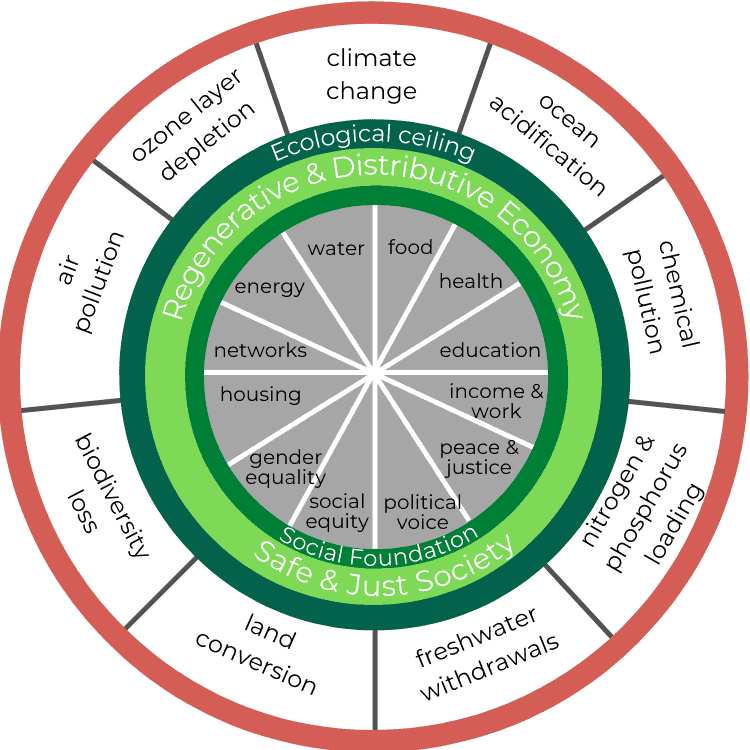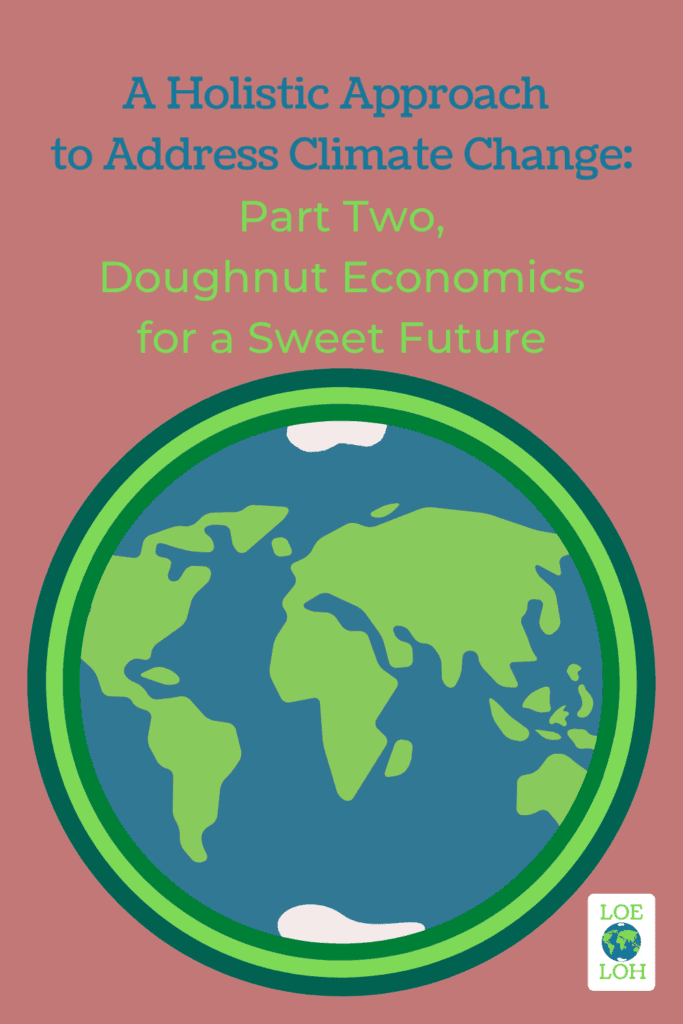Addressing climate change involves a whole lot more than reducing greenhouse gas emissions, it requires a holistic approach. This is a big topic, so I’ve split it up into a three part series. Previously, in part one, we reviewed the historical intersections climate change to recognize why we need a holistic approach. Here, in part two, we are looking at Doughnut Economics. An economic framework that centers the needs of people and Earth. Finally, in part three, we will review holistic approaches that have already taken place. Also, what we can do to be a part of implementing more.
Doughnut Economics is an economic model created by Kate Raworth that guides us to a future where our economy, basic human needs, and Earth’s natural systems can all thrive together. A holistic approach to climate change in our economy is what Kate Raworth’s Doughnut economics is all about. Let’s dive in.
Our Current Economy
In her TED talk, Ms. Raworth explained that our current economy is based on the idea of perpetual growth. The concept of today’s economy was described by W.W. Rostow in his book from 1960, The Stages of Economic Growth. The final stage is the Age of Mass Consumerism. She continues that as a whole we are addicted to growth. The idea of growth is frequently provided as both a goal and a solution for financial, social, and political issues. For example to maintain or achieve political power, the GDP (Gross Domestic Product) needs to grow. Also, through advertising we’ve been told that continuing to purchase goods will transform our lives and make us happy.
The catch to the idea of unceasing economic growth is Earth’s planetary boundaries. We are living in the after effects of this enduring growth. Experiencing large swaths of species extinction, pollution, and climate change. Additionally, the economy has favored the wealth to just 1% of the global population, widening wealth inequality. Which leaves more and more people whose basic human needs are not fulfilled.
How do we fix an economy that intensifies social inequalities and pushes the natural limits of our shared home to be unlivable? Ms. Raworth’s answer is to transform our economy from continuous growth to one that thrives in the Doughnut.
A Sweet Future in Doughnut Economics
The Doughnut Economy is a framework that centers around the planetary boundaries of Earth’s life supporting systems and the social needs of us as humans. Below is a recreation of Ms. Raworth’s Doughnut economy.

The dark green ring of the doughnut represents the ecological ceiling limit of Earth’s 9 life supporting systems. These include biodiversity, ocean acidification, air pollution, and climate change. While inside the doughnut hole are communities and people whose 12 societal needs are not being met. The societal needs to be met are food, health, education, income and work, peace and justice, political voice, social equity, gender equality, housing, networks, energy and water. The goal is to uplift people in the middle of the Doughnut whose needs are not being met while not exceeding the ecological ceilings of Earth.
Between the outside ring and the hole in the middle is the “sweet spot.” In this sweet spot our society is safe and just meeting social needs while living within Earth’s ecological ceiling. In the Doughnut, the economy has been cultivated into a regenerative and distributive system rather than one pushed to grow endlessly. She describes a regenerative economy is one that “works with and within the cycles of the living world…where waste from one process is food for the next.” Also the economy shifts from a centralized to a distributive system. This provides current institutions vast opportunities to distribute wealth, technology, and knowledge.
A Whole Doughnut to Consider
Ms. Raworth explains Doughnut Economics does not give answers but provides a guide with a “dashboard of markers.” These markers offer a holistic approach to transform our economy to one that thrives, meeting society’s needs within Earth’s boundaries.
She ends her speech with this bit of inspiration, “And if the mere idea of boundaries makes you feel, well, bounded, think again. Because the world’s most ingenious people turn boundaries into the source of their creativity. From Mozart on his five-octave piano, Jimi Hendrix on his six-string guitar, Serena Williams on a tennis court, it’s boundaries that unleash our potential. And the doughnut’s boundaries unleash the potential for humanity to thrive with boundless creativity, participation, belonging and meaning. It’s going to take all the ingenuity that we have got to get there, so bring it on.”
With a Doughnut Economy, we have a framework for a holistic approach to address climate change that encircles our economy, social justices, and Earth’s planetary limits. In part three we will look at examples of holistic approaches in action and opportunities for each us to be a part of our sweet transformative future.


